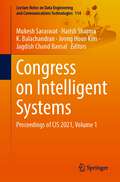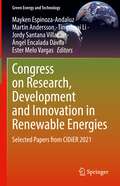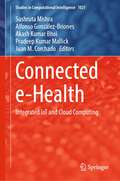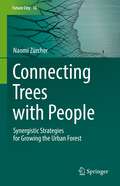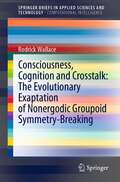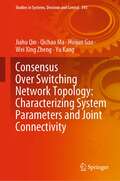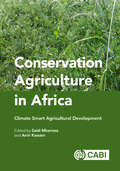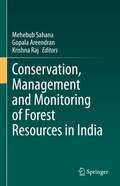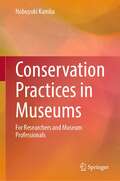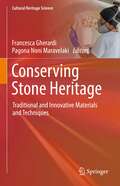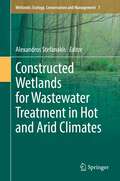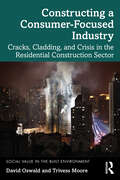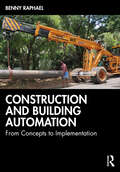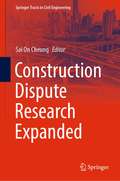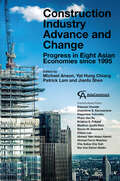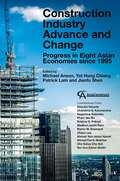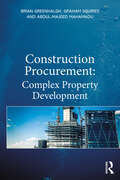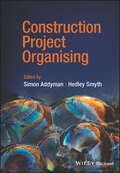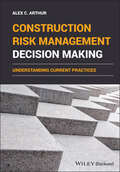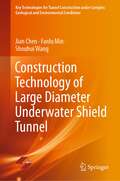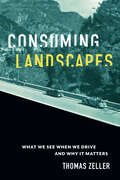- Table View
- List View
Congress on Intelligent Systems: Proceedings of CIS 2021, Volume 1 (Lecture Notes on Data Engineering and Communications Technologies #114)
by Mukesh Saraswat Harish Sharma K. Balachandran Joong Hoon Kim Jagdish Chand BansalThis book is a collection of selected papers presented at the Second Congress on Intelligent Systems (CIS 2021), organized by Soft Computing Research Society and CHRIST (Deemed to be University), Bengaluru, India, during September 4 – 5, 2021. It includes novel and innovative work from experts, practitioners, scientists, and decision-makers from academia and industry. It covers topics such as Internet of things, information security, embedded systems, real-time systems, cloud computing, big data analysis, quantum computing, automation systems, bio-inspired intelligence, cognitive systems, cyber physical systems, data analytics, data/web mining, data science, intelligence for security, intelligent decision making systems, intelligent information processing, intelligent transportation, artificial intelligence for machine vision, imaging sensors technology, image segmentation, convolutional neural network, image/video classification, soft computing for machine vision, pattern recognition, human–computer interaction, robotic devices and systems, autonomous vehicles, intelligent control systems, human motor control, game playing, evolutionary algorithms, swarm optimization, neural network, deep learning, supervised learning, unsupervised learning, fuzzy logic, rough sets, computational optimization, and neuro-fuzzy systems.
Congress on Research, Development and Innovation in Renewable Energies: Selected Papers from CIDiER 2021 (Green Energy and Technology)
by Mayken Espinoza-Andaluz Martin Andersson Tingshuai Li Jordy Santana Villamar Ángel Encalada Dávila Ester Melo VargasThe 2021 Congress on Research, Development and Innovation in Renewable Energies (CIDiER 2021) aims to promote international collaboration that fosters ideas and dialogue on developing a solution to climate change through research and development that leads to clean energy innovation via renewable energies. These selected papers cover both theoretical and applied research that will strengthen the implementation of renewable energy projects between universities, research centers, and private companies.
Connected e-Health: Integrated IoT and Cloud Computing (Studies in Computational Intelligence #1021)
by Juan M. Corchado Akash Kumar Bhoi Pradeep Kumar Mallick Alfonso González-Briones Sushruta MishraWith rise of smart medical sensors, cloud computing and the health care technologies, “connected health” is getting remarkable consideration everywhere. Recently, the Internet of Things (IoT) has brought the vision of a smarter world into reality. Cloud computing fits well in this scenario as it can provide high quality of clinical experience. Thus an IoT-cloud convergence can play a vital role in healthcare by offering better insight of heterogeneous healthcare content supporting quality care. It can also support powerful processing and storage facilities of huge data to provide automated decision making. This book aims to report quality research on recent advances towards IoT-Cloud convergence for smart healthcare, more specifically to the state-of-the-art approaches, design, development and innovative use of those convergence methods for providing insights into healthcare service demands. Students, researchers, and medical experts in the field of information technology, medicine, cloud computing, soft computing technologies, IoT and the related fields can benefit from this handbook in handling real-time challenges in healthcare. Current books are limited to focus either on soft computing algorithms or smart healthcare. Integration of smart and cloud computing models in healthcare resulting in connected health is explored in detail in this book.
Connecting Trees with People: Synergistic Strategies for Growing the Urban Forest (Future City #16)
by Naomi ZürcherWritten from the perspective of an urban forester and certified arborist, the reader will have a basic understanding of what makes a tree a tree in context to the philosophical and cultural underpinnings of Urban and Community Forestry, and learn how to implement model, time-tested global green practices and initiatives derived from citizen science.
Consciousness, Cognition and Crosstalk: The Evolutionary Exaptation of Nonergodic Groupoid Symmetry-Breaking (SpringerBriefs in Applied Sciences and Technology)
by Rodrick WallaceThis book makes application to the dynamics of arousal and distraction, and to other examples. A modified version of the Kadanoff picture of phase transitions in consciousness emerges from the Morse Function itself in a surprisingly standard manner, closely associated with the breaking of groupoid symmetries driven by fundamental equivalence class algebras. Although this is far indeed from the familiar world of physical theory, it should be possible, on the basis of the probability models developed in the book, to develop new statistical tools for the analysis of observational and empirical data regarding cognition and consciousness.
Consensus Over Switching Network Topology: Characterizing System Parameters and Joint Connectivity (Studies in Systems, Decision and Control #393)
by Jiahu Qin Qichao Ma Huijun Gao Wei Xing Zheng Yu KangThis book aims to extend existing works on consensus of multi-agent systems systematically. The agents to be considered range from double integrators to generic linear systems. The primary goal is to explicitly characterize how agent parameters, which reflect both self-dynamics and inner coupling of each agent, and switching network topologies jointly influence the collective behaviors. A series of necessary and/or sufficient conditions for exponential consensus are derived. The contents of this book are as follows. Chapter 1 provides the background and briefly reviews the advances of consensus of multi-agent systems. Chapter 2 addresses the consensus problem of double integrators over directed switching network topologies. It is proven that exponential consensus can be secured under very mild conditions incorporating the damping gain and network topology. Chapter 3 considers generic linear systems with undirected switching network topologies. Necessary and sufficient conditions on agent parameters and connectivity of the communication graph for exponential consensus are provided. Chapter 4 furthers the study of consensus for multiple generic linear systems by considering directed switching network topologies. How agent parameters and joint connectivity work together for reaching consensus is characterized from an algebraic and geometric view. Chapter 5 extends the design and analysis methodology to containment control problem, where there exist multiple leaders. A novel analysis framework from the perspective of state transition matrix is developed. This framework relates containment to consensus and overcomes the difficulty of construction of a containment error.This book serves as a reference to the main research issues and results on consensus of multi-agent systems. Some prerequisites for reading this book include linear system theory, matrix theory, mathematics, and so on.
Conservation Agriculture in Africa: Climate Smart Agricultural Development
by Mohamed Annabi Haithem Bahri Mloza Banda Gotlieb Basch Richard Bell Alexandra Bot Trent W Bunderson Martin Bwalya Hatem Cheikh M’hamed Cornelius Chiduza Cary Clark Demba Diakhaté Mazwi Dlamini Sjoerd Duiker Alioune Fall Aymen Frija Patrick Gicheru Josiah Gitari Tom Goddard Emilio Gonzalez-Sanchez Isaac Gura Enamul Haque Michel Havard Zied Idoudi Mohammad Jahiruddin Zwide D Jere Josef Kienzle Onesmos Kitonyo Erna Kruger Peter Kuria Phlorentin Philip Lagwen Simon Lugandu Ngari Macharia Temakholo Mathebula Sixolise Mcinga Alfred Micheni Neil Miller Frank Mmbando Rachid Moussadek Pearson Nyari Mnkeni Rachid Mrabet Ndabhemeye Mulengera Walter Mupangwa Joseph Mureithi R. M. Museka Weldone Mutai Munyaradzi Mutenje Lindah Muzangwa Remmy Mwakimbwala Andre A Nel James Njeru Rama Ngatoluwa Phumzile Ngcobo Isaiah Nyagumbo Putso Nyathi Ricardo Ralisch Leonard Rusinamhodzi John Sariah Ibrahima Sarr Peter Setimela Richard Shetto Reynolds K. Shula Brian G. Sims Hendrik J. Smith Dimas Soares Júnior Peter Steward Johann Strauss Christian Thierfelder Gerhardus Trytsman Jean Twilingiyumukiza Carl Wahl Peter Waweru Nouhoun ZampaligreTillage agriculture has led to widespread soil and ecosystem degradation globally, and more particularly in the developing regions. This is especially so in Africa where traditional agricultural practices have become unsustainable due to severe exploitation of natural resources with negative impacts on the environment and food system. In addition, agricultural land use in Africa today faces major challenges including increased costs, climate change and a need to transform to more sustainable production intensification systems. Conservation Agriculture has emerged as a major alternative sustainable climate smart agriculture approach in Africa and has spread to many African countries in the past decade as more development and research, including in sustainable mechanization, has enabled its extension and uptake. It is key to transforming Africa's agriculture and food system given its ability to restore soil health, biodiversity and productivity of millions of smallholder farms as well as larger-scale farms. This landmark volume is based on the material presented at the Second Africa Congress on Conservation Agriculture which was held in Johannesburg, South Africa, 9-12 October 2018. The main theme of the Congress was 'Making Climate Smart Agriculture Real in Africa with Conservation Agriculture: Supporting the Malabo Declaration and Agenda 2063'. The Congress was aligned to mobilize stakeholders in all agriculture sectors to provide greater technical, institutional, development and investment support, impetus and direction to the vision and agenda for transforming African agriculture as set out by the Malabo Declaration and Agenda 2063. This book is aimed at all agricultural stakeholders in the public, private and civil sectors in Africa engaged in supporting the transformation of conventional tillage agriculture to Conservation Agriculture. The book will be of interest to: researchers, academics, students, development stakeholders, public and private sector investors and policy makers as well as institutional libraries across the world.
Conservation, Management and Monitoring of Forest Resources in India
by Mehebub Sahana Gopala Areendran Krishna RajThis volume is devoted to compiling recent advancements, methodological improvements, new processing techniques, integration methods and rigorous applications associated with conceptual techniques on the conservation and monitoring of forest resources for a scientific audience, with a focus on cases and applications in India. The primary objective of the book is to advance the scientific understanding of the recent trends and technological improvements in forest conservation, management and related research themes in forest resources and human-wildlife interactions. The book is organized into five sections: (I) Forest Conservation Ecology (II) Forest Conservation and Society (III) Forest Management (IV) Forest Monitoring using GIS and Remote Sensing and (V) Human Wildlife Conflicts. It covers various research themes related to forestry, wildlife, habitat fragmentation, forest management and human-wildlife conflict research, and therefore will be beneficial to a diverse range of researchers, scientific organizations, wildlife scientists, biologists, ecologists and planners in the fields of wildlife and forestry. The book will further be of use to post-graduates, PhD research scholars, professors, geospatial experts, modellers, foresters, agricultural scientists, biologists, ecologists, environmental consultants and big data compilers.
Conservation Practices in Museums: For Researchers and Museum Professionals
by Nobuyuki KambaThe author introduces conservation science and management of cultural heritages in museums. In particular, a comprehensive conservation study and practical techniques are described. Aspects such as examination and diagnosis of cultural heritage by scientific data recording of humidity, luminosity, intensity of vibration and shock, among others, are introduced. Preventive and remedial conservation with X-ray imaging and X-ray fluorescence and other risk-control methods are also explained. The author provides basic theories based on a scientific view for the methods introduced in this book. They can be compared with those used at other museums, and readers can employ them to adapt and improve their methods. Today, maintaining smooth internal communication is key for scientists and curators with different academic backgrounds and from different departments working together on conservation projects at the museum.The author addresses the current global trend of preserving rather than repairing cultural heritage at museums and emphasizes its importance.
Conserving Stone Heritage: Traditional and Innovative Materials and Techniques (Cultural Heritage Science)
by Francesca Gherardi Pagona Noni MaravelakiThe design of treatments for the conservation of stone in historical buildings and works of art is a challenging task, as a deep understanding of the working properties and performance of the available products and methods is required to tackle complex decay patterns.The chapters in this book illustrate the state of the art on traditional and innovative materials and methods for stone conservation, examining current trends and future perspectives. Each of them is focused on describing the consequent phases that complement the spectrum of the conservation intervention: preliminary investigations, condition assessment, and mapping of the deterioration patterns; surface cleaning, with a specific focus on laser technology; consolidation; protection; repair mortars and grouts; and onsite assessment and monitoring of conservation treatments. The performance of the applied conservation interventions is criticized and discussed with an aim of providing the specialists with specific tools for stone conservation. This book intends to bridge the gap between laboratory studies and conservation interventions, by linking together the diverse scientific areas involved in the preservation of stone heritage. Different case studies are included, highlighting specific conservation challenges and their solutions in order to understand and overcome them. The aim is to guide conservators, conservation scientists and heritage stakeholders in the selection of compatible and sustainable materials and techniques for Conserving Stone Heritage.
Constructed Wetlands for Wastewater Treatment in Hot and Arid Climates (Wetlands: Ecology, Conservation And Management Ser. #7)
by Alexandros StefanakisConstructing a Consumer-Focused Industry: Cracks, Cladding and Crisis in the Residential Construction Sector (Social Value in the Built Environment)
by David Oswald Trivess MooreThe old saying ‘safe as houses’ is being challenged around the world like never before. Over recent decades homeowners have experienced the devastating effects of defects like asbestos, leaky buildings, structural failings, and more recently the combustible cladding crisis. The provision of safe and secure housing is a critical starting point to ensure that social value can be delivered in the built environment. However, some of these dangerous defects have resulted in a lack of security, safety, health, well-being, and social value for households and the wider community. The problems homeowners experience go beyond the substantial financial costs for defect rectification. Too often there has been a lack of government and industry support to help the housing consumer through these issues or to prevent them from occurring to begin with. It is time for a rethink and restructure of government policy, support, and industry practices to better protect housing consumers and deliver high-quality and sustainable housing that creates social value. Through evidence-based research and international case studies, this book focuses on the effects that dangerous defects have on the housing consumer. The ongoing construction cladding crisis is used as a primary case study throughout to highlight these implications, with other previous large-scale defect examples, such as leaky buildings and asbestos. Based upon the range of emerging evidence, we propose ideas for policy makers, construction and built environment professionals, owners corporations, and households on how to move forward towards a higher-quality, sustainable, and socially valuable way of residential living. Government policy has long focused on ‘making industry work’ through building regulations and standards. It is now time for greater government and industry focus on the consumer to make ‘consumer protection work’ in the built environment. There is a need to prevent dangerous defects like combustible cladding, better support consumers when defects emerge, and to create buildings for social value rather than minimum standards. Now is the time to build a better future for the end-user.
Constructing a Consumer-Focused Industry: Cracks, Cladding and Crisis in the Residential Construction Sector (Social Value in the Built Environment)
by David Oswald Trivess MooreThe old saying ‘safe as houses’ is being challenged around the world like never before. Over recent decades homeowners have experienced the devastating effects of defects like asbestos, leaky buildings, structural failings, and more recently the combustible cladding crisis. The provision of safe and secure housing is a critical starting point to ensure that social value can be delivered in the built environment. However, some of these dangerous defects have resulted in a lack of security, safety, health, well-being, and social value for households and the wider community. The problems homeowners experience go beyond the substantial financial costs for defect rectification. Too often there has been a lack of government and industry support to help the housing consumer through these issues or to prevent them from occurring to begin with. It is time for a rethink and restructure of government policy, support, and industry practices to better protect housing consumers and deliver high-quality and sustainable housing that creates social value. Through evidence-based research and international case studies, this book focuses on the effects that dangerous defects have on the housing consumer. The ongoing construction cladding crisis is used as a primary case study throughout to highlight these implications, with other previous large-scale defect examples, such as leaky buildings and asbestos. Based upon the range of emerging evidence, we propose ideas for policy makers, construction and built environment professionals, owners corporations, and households on how to move forward towards a higher-quality, sustainable, and socially valuable way of residential living. Government policy has long focused on ‘making industry work’ through building regulations and standards. It is now time for greater government and industry focus on the consumer to make ‘consumer protection work’ in the built environment. There is a need to prevent dangerous defects like combustible cladding, better support consumers when defects emerge, and to create buildings for social value rather than minimum standards. Now is the time to build a better future for the end-user.
Construction and Building Automation: From Concepts to Implementation
by Benny RaphaelThis book is intended to be used as a textbook in undergraduate civil engineering and construction courses to introduce cutting edge mechanical, electrical, and computer science topics that are needed for civil and construction engineers to collaborate in inter-disciplinary automation projects. Part I introduces the basics of hardware and software technologies that are needed for implementing automation in buildings and construction. The content begins with the fundamental concepts and uses practical examples to bring out the benefits of automation through case studies that are easy to understand. No other book uniformly treats the subject of automation within the context of buildings and construction activities. While the technology needed for these two application domains are similar, the unifying principles are not well recognized. This book will bring out the fundamental principles that could form the basis of application to these two domains. For example, it will become clear that sensors, actuators, and controllers, along with smart control strategies could be used for automating tasks within buildings and on construction sites. Part II of the book will introduce key advances in the areas of machine learning and artificial intelligence that are significant for the intelligent control of buildings and construction equipment. Control algorithms and techniques for data analytics are explained in a form that is appropriate for non-computer science students. Each chapter contains several hands-on exercises meant to apply the principles that are covered. These include numerical problems as well as design and analysis examples. This new textbook: • Introduces hardware and software needed for automating engineering tasks • Presents examples of applications in the control of building systems • Illustrates of the use of automation for improving construction processes • Provides a lucid introduction to advanced computing concepts, machine learning, artificial intelligence, and control algorithms to construction and engineering students. It is sure to be essential reading for a growing number of courses in smart construction, building automation, robotics, intelligent buildings, and construction 4.0. Supplementary material including answers to exercises in the book will be provided on the author’s website: https://bennyraphael.com/book2022/
Construction and Building Automation: From Concepts to Implementation
by Benny RaphaelThis book is intended to be used as a textbook in undergraduate civil engineering and construction courses to introduce cutting edge mechanical, electrical, and computer science topics that are needed for civil and construction engineers to collaborate in inter-disciplinary automation projects. Part I introduces the basics of hardware and software technologies that are needed for implementing automation in buildings and construction. The content begins with the fundamental concepts and uses practical examples to bring out the benefits of automation through case studies that are easy to understand. No other book uniformly treats the subject of automation within the context of buildings and construction activities. While the technology needed for these two application domains are similar, the unifying principles are not well recognized. This book will bring out the fundamental principles that could form the basis of application to these two domains. For example, it will become clear that sensors, actuators, and controllers, along with smart control strategies could be used for automating tasks within buildings and on construction sites. Part II of the book will introduce key advances in the areas of machine learning and artificial intelligence that are significant for the intelligent control of buildings and construction equipment. Control algorithms and techniques for data analytics are explained in a form that is appropriate for non-computer science students. Each chapter contains several hands-on exercises meant to apply the principles that are covered. These include numerical problems as well as design and analysis examples. This new textbook: • Introduces hardware and software needed for automating engineering tasks • Presents examples of applications in the control of building systems • Illustrates of the use of automation for improving construction processes • Provides a lucid introduction to advanced computing concepts, machine learning, artificial intelligence, and control algorithms to construction and engineering students. It is sure to be essential reading for a growing number of courses in smart construction, building automation, robotics, intelligent buildings, and construction 4.0. Supplementary material including answers to exercises in the book will be provided on the author’s website: https://bennyraphael.com/book2022/
Construction Dispute Research Expanded (Springer Tracts in Civil Engineering)
by Sai On CheungAs an expansion of the book “Construction Dispute Research” published in 2014, this book presents further contributions and breaks into three new research foci in construction dispute studies. Part A discusses the conceptualization and minimization of biases in construction dispute decisions; Part B examines other impediments against settlement such as inequity, power asymmetry and loss aversion. Part C focuses on realty check of construction dispute negotiation conditions such as market competition, interdependence of contracting parties and dispute avoidance function of construction incentivization. This book showcases new ideas in construction dispute research. It offers research studies that are theory rich and conducted with robust methodologies. The research implications are practical and implementable.
Construction Industry Advance and Change: Progress in Eight Asian Economies since 1995
by Michael Anson, Y. H. Chiang, Patrick T. I. Lam, Jianfu F. ShenA nation’s construction industry is essentially home grown, a derivative of its culture, history, geography and economic circumstances with every building or road a unique product, always a prototype, unlike the honed prototypes set up for efficient production runs of other industries. In terms of what was built and the standards achieved, Construction Industry Advance and Change: Progress in Eight Asian Economies since 1995 describes construction industry progress between 1995 and 2019 in Hong Kong , India, Indonesia, Japan, Malaysia, South Korea, Sri Lanka and Vietnam. The 25-year accounts provide insight into the nature of these individual construction industries, their shared characteristics, and their differing priorities. The book will add knowledge and contextual reference for construction industry professionals, public policy makers and academic researchers studying the industry. New students in construction industry management courses, will find the information and context needed to appreciate the nature of construction industries and the factors affecting industry output performance.
Construction Industry Advance and Change: Progress in Eight Asian Economies since 1995
by Michael Anson Yat Hung Chiang Patrick Lam Jianfu ShenA nation’s construction industry is essentially home grown, a derivative of its culture, history, geography and economic circumstances with every building or road a unique product, always a prototype, unlike the honed prototypes set up for efficient production runs of other industries. In terms of what was built and the standards achieved, Construction Industry Advance and Change: Progress in Eight Asian Economies since 1995 describes construction industry progress between 1995 and 2019 in Hong Kong , India, Indonesia, Japan, Malaysia, South Korea, Sri Lanka and Vietnam. The 25-year accounts provide insight into the nature of these individual construction industries, their shared characteristics, and their differing priorities. The book will add knowledge and contextual reference for construction industry professionals, public policy makers and academic researchers studying the industry. New students in construction industry management courses, will find the information and context needed to appreciate the nature of construction industries and the factors affecting industry output performance.
Construction Procurement: Complex Property Development
by Brian Greenhalgh Graham Squires Abdul-Majeed MahamaduThis book is an easy-to-read introduction to the principles and methods of building procurement and is aimed at first year students or non-cognate graduates starting out on a career in construction, property, quantity surveying and construction management. The book starts with a brief introduction to the construction industry, including how the industry is organised into contractors, consultants and clients. After a discussion of the historical development of procurement methods, which show a steady shift of risk and responsibility towards the supply side (contractors), the various roles and responsibilities which must be carried out in any project are discussed in detail. The aim is to show the reader that procurement routes are effectively a permutation of these responsibilities between the various parties. The book then explains the various methods by which the contractor(s) are paid, either by pre-negotiated lump sums or by some form of cost reimbursement. Variants of these two systems are also discussed. Several chapters are given to the detailed discussion of the main procurement routes together with the appropriate standard forms of contract designed for that route. More modern developments such as Private Financing and PPP are discussed and a chapter covering emerging trends in procurement completes the book. Containing discussion points, chapter summaries and case studies, this book is ideal for use in a variety of degree programs and courses across the built environment and engineering.
Construction Procurement: Complex Property Development
by Brian Greenhalgh Graham Squires Abdul-Majeed MahamaduThis book is an easy-to-read introduction to the principles and methods of building procurement and is aimed at first year students or non-cognate graduates starting out on a career in construction, property, quantity surveying and construction management. The book starts with a brief introduction to the construction industry, including how the industry is organised into contractors, consultants and clients. After a discussion of the historical development of procurement methods, which show a steady shift of risk and responsibility towards the supply side (contractors), the various roles and responsibilities which must be carried out in any project are discussed in detail. The aim is to show the reader that procurement routes are effectively a permutation of these responsibilities between the various parties. The book then explains the various methods by which the contractor(s) are paid, either by pre-negotiated lump sums or by some form of cost reimbursement. Variants of these two systems are also discussed. Several chapters are given to the detailed discussion of the main procurement routes together with the appropriate standard forms of contract designed for that route. More modern developments such as Private Financing and PPP are discussed and a chapter covering emerging trends in procurement completes the book. Containing discussion points, chapter summaries and case studies, this book is ideal for use in a variety of degree programs and courses across the built environment and engineering.
Construction Project Organising
by Simon Addyman Hedley SmythConstruction Project Organising Discover foundational and cutting-edge ideas in the organisation of construction projects In Construction Project Organising, an authoritative team of construction researchers delivers a comprehensive exploration of the many organisational processes and forms that can be found in construction project organising and the many dimensions that can influence these forms. The authors examine these dimensions, detailing their importance to projects and enabling managers to respond to calls by industry professionals for more collaborative forms of organising that focus on value creation. The book investigates the relationship between structure and action, and how patterns of action are created, recreated and maintained by scrutinising the myriad of organisational arrangements between clients, financiers, design teams, contractors, stakeholders and supply chains. It also discusses different concepts in the development and management of construction project organisations, including formation and maintenance issues. Construction Project Organising highlights some of the key issues that remain underdeveloped in the modern literature. It also includes: A thorough description of the rapidly changing socio-economic, technological, digital and data-driven context in which construction projects are designed and delivered A comprehensive examination of different concepts in the development and management of construction project organisations A practical investigation of the relationship between structure and action and how action patterns are created, recreated and maintained Grounded advice to help readers respond to calls by industry for more collaborative forms of project organisation focused on value creation Perfect for researchers, academics and advanced students of construction and similar disciplines, Construction Project Organising is also a must-read resource for construction professionals and the consultants who serve them.
Construction Project Organising
by Simon Addyman Hedley SmythConstruction Project Organising Discover foundational and cutting-edge ideas in the organisation of construction projects In Construction Project Organising, an authoritative team of construction researchers delivers a comprehensive exploration of the many organisational processes and forms that can be found in construction project organising and the many dimensions that can influence these forms. The authors examine these dimensions, detailing their importance to projects and enabling managers to respond to calls by industry professionals for more collaborative forms of organising that focus on value creation. The book investigates the relationship between structure and action, and how patterns of action are created, recreated and maintained by scrutinising the myriad of organisational arrangements between clients, financiers, design teams, contractors, stakeholders and supply chains. It also discusses different concepts in the development and management of construction project organisations, including formation and maintenance issues. Construction Project Organising highlights some of the key issues that remain underdeveloped in the modern literature. It also includes: A thorough description of the rapidly changing socio-economic, technological, digital and data-driven context in which construction projects are designed and delivered A comprehensive examination of different concepts in the development and management of construction project organisations A practical investigation of the relationship between structure and action and how action patterns are created, recreated and maintained Grounded advice to help readers respond to calls by industry for more collaborative forms of project organisation focused on value creation Perfect for researchers, academics and advanced students of construction and similar disciplines, Construction Project Organising is also a must-read resource for construction professionals and the consultants who serve them.
Construction Risk Management Decision Making: Understanding Current Practices
by Alex C. ArthurCONSTRUCTION RISK MANAGEMENT DECISION MAKING Explores the relevance of systems thinking and behavioral science in construction risk management Effective risk management is a vital component of all successful construction projects. Although quantitative tools for evaluating data and minimizing risk are readily available, construction managers commonly adopt a more innate, experience-based approach. In Construction Risk Management Decision Making, project manager and senior consultant Alex C. Arthur provides step-by-step advice on assessing and prioritizing risk using qualitative decision-making systems in the construction industry. Incorporating key theories and concepts from systems thinking and behavioral science, this highly practical guide focuses on the behavior patterns of real people in the industry, rather than complex quantitative techniques and data. Concise, easy-to-understand chapters highlight the current practices of construction risk management while helping readers view risk and decision making from a broader perspective. Throughout the book, the author presents invaluable insights into the ways construction professionals think and behave in the real world. Addresses the actual risk management practices of construction professionals Applies human behavioral theories to the study of construction risk management decision making Illustrates the highly intuitive approaches prevalent in various construction projects Features real-life case studies and practical examples throughout Construction Risk Management Decision Making is an excellent textbook for advanced students in project management, engineering, construction, and surveying courses, and a must-have guide for practitioners of construction management, surveying, and architecture.
Construction Technology of Large Diameter Underwater Shield Tunnel (Key Technologies for Tunnel Construction under Complex Geological and Environmental Conditions)
by Jian Chen Fanlu Min Shouhui WangThis book systematically introduces the new technology used in the construction of underwater large slurry shields under complex conditions. The basic principles, scope of application, construction technology and technical points of the key technologies such as the origin and arrival of the shield, crossing the shallow soil in the middle of the river, crossing the guard, and changing the knife and opening the knife are clarified.
Consuming Landscapes: What We See When We Drive and Why It Matters
by Thomas ZellerWhat we see through our windshields reflects ideas about our national identity, consumerism, and infrastructure.For better or worse, windshields have become a major frame for viewing the nonhuman world. The view from the road is one of the main ways in which we experience our environments. These vistas are the result of deliberate historical forces, and humans have shaped them as they simultaneously sought to be transformed by them. In Consuming Landscapes, Thomas Zeller explores how what we see while driving reflects how we view our societies and ourselves, the role that consumerism plays in our infrastructure, and ideas about reshaping the environment in the twentieth century.Zeller breaks new ground by comparing the driving experience and the history of landscaped roads in the United States and Germany, two major automotive countries. He focuses specifically on the Blue Ridge Parkway in the United States and the German Alpine Road as case studies. When the automobile was still young, an early twentieth-century group of designers—landscape architects, civil engineers, and planners—sought to build scenic infrastructures, or roads that would immerse drivers in the landscapes that they were traversing. As more Americans and Europeans owned cars and drove them, however, they became less interested in enchanted views; safety became more important than beauty. Clashes between designers and drivers resulted in different visions of landscapes made for automobiles. As strange as it may seem to twenty-first-century readers, many professionals in the early twentieth century envisioned cars and roads, if properly managed, as saviors of the environment. Consuming Landscapes illustrates how the meaning of infrastructures changed as a result of use and consumption. Such changes indicate a deep ambivalence toward the automobile and roads, prompting the question: can cars and roads bring us closer to nature while deeply altering it at the same time?
